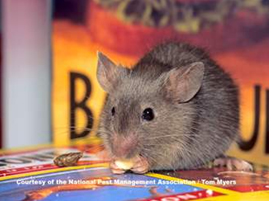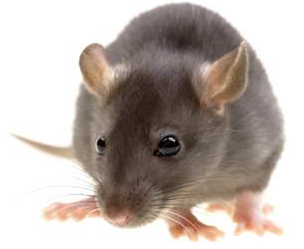Rodents
Rodents mainly Rats and Mice can be difficult to keep out of structures. For instance, mice can squeeze through spaces as small as a dime and rats can fit through holes the size of a quarter. For proper rodent pest control, seal any cracks and voids. Ensure there is proper drainage at the foundation and always install gutters or diverts which will channel water away from the building. A rodent exterminator can also help you identify ways in which a rodent may be entering your home.
House Mice – Mus Domesticus

The house mouse is the most commonly encountered and economically important of the commensal (that live in close proximity to humans) rodents. House mice are of Central Asian origin, but they are distributed worldwide. House mice are not only a nuisance, but they can pose significant health and property threats.
House mice breed rapidly and can adapt quickly to changing conditions. In fact, a female house mouse can give birth to a half dozen babies every three weeks and can produce up to 35 young per year.
To keep mice and other rodents out, make sure all holes larger than a dime and gaps wider than a pencil are sealed with silicone-based caulk, steel wool, or other construction material. Keep areas clear and store boxes off the floor, as mice can hide in clutter. Store food in sealed glass or metal containers. Leave surfaces clear of crumbs and food morsels, which may attract house mice.
Roof Rats Rattus rattus

The roof rat is the smaller of the two commensal (that live in close proximity to humans) rats, as the Norway rat is larger in size. Roof rats are also referred to as black rats or ship rats. The roof rat gets its name from its tendency to find shelter in the upper parts of buildings. Once inside, roof rats not only damage materials by gnawing through them, bust they also contaminate stored food and serve as vectors of dangerous diseases.
Roof rats are thought to be of Southeast Asian origin, but they are now found worldwide, especially in the tropical regions.
Roof rats are long and thin rodents that have large eyes and ears, a pointed nose and a scaly tail. Roof rats have soft and smooth fur that is typically brown with intermixed spots of black. Their undersides are often white, gray or black.
To prevent a roof rat infestation, seal up any holes or cracks larger than a quarter with silicone caulk and be sure that all windows and vents are screened. Keep trees and shrubs trimmed away from the building and cut back limbs overhanging the roof. Roof rats are drawn to any accessible food sources, so clean up fruit that may fall from trees in the yard and keep garbage in tightly covered receptacles. Be sure to also store pet food and other dry food in sealed containers. Additionally, eliminate any outdoor sources of water such as leaky sprinkler heads, pet water dishes and birdbaths.
Contact Entotox office in your region for a pest management and extermination plan


